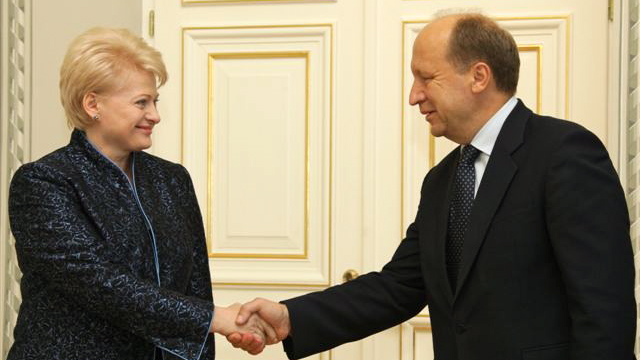SoDra, state institutions targeted
VILNIUS — Despite its recovering economy, it appears Lithuania’s age of austerity that has defined government policies since the economic crisis hit in late 2008 is not leaving anytime soon. In a meeting on Tuesday morning Lithuanian President


President Grybauskaitė (left) and Prime Andrius Kubilius shake hands during their meeting on Tuesday. Both are largely in agreement on how the government should address SoDra and poorly-run state companies. The left-wing parties in the parliament strongly oppose both initiatives, though. Photo by the Office of the President of the Republic of Lithuania.
VILNIUS — Despite its recovering economy, it appears Lithuania’s age of austerity that has defined government policies since the economic crisis hit in late 2008 is not leaving anytime soon.
In a meeting on Tuesday morning Lithuanian President Dalia Grybauskaitė and Prime Minister Andrius Kubilius agreed that tackling SoDra’s imbalances and the mismanagement of state institutions will be one of the goverment’s primary goals for the next year.
At a post-meeting press conference, Kubilius said that both were priorities given the additional fiscal consolidation Lithuania must undertake if it is to meet the Maastricht Criteria for eurozone entry.
“Life continues to be prudent and budget decisions are related to various cost reductions … particularly in the social sphere,” Kubilius said.
Presidential spokesman Linas Balsys emphasized Grybauskaitė’s commitment to a leaner version of SoDra.
“The president would like to see a full SoDra reform, not just some individual aspects of reform but a complete, conceptually prepared overhaul,” Balsys told reporters.
SoDra, Lithuania’s state social security fund administers health care coverage in the public system, pensions and other social welfare benefits. The fund’s long-term solvency is under question given Lithuania’s rapidly aging population, low birth rate and large-scale migration of working-age people from the small Baltic state to Western Europe. The fund, like many Lithuanian state institutions, has also come under fire for wasteful spending such as spending four million litai (€1.1 million) on new computers last year in disregard of the government’s belt-tightening measures.
Exactly what the ruling coalition’s vision of a reformed SoDra may look like remains to be seen, although cuts in benefits and an increase in the retirement age to 65 for both men and women implemented gradually over the next 15 years are likely to be proposed.
This article is free to view. To read Baltic Reports’ subscription-only articles, click here.
Related
Beholder 3 Part 9









































